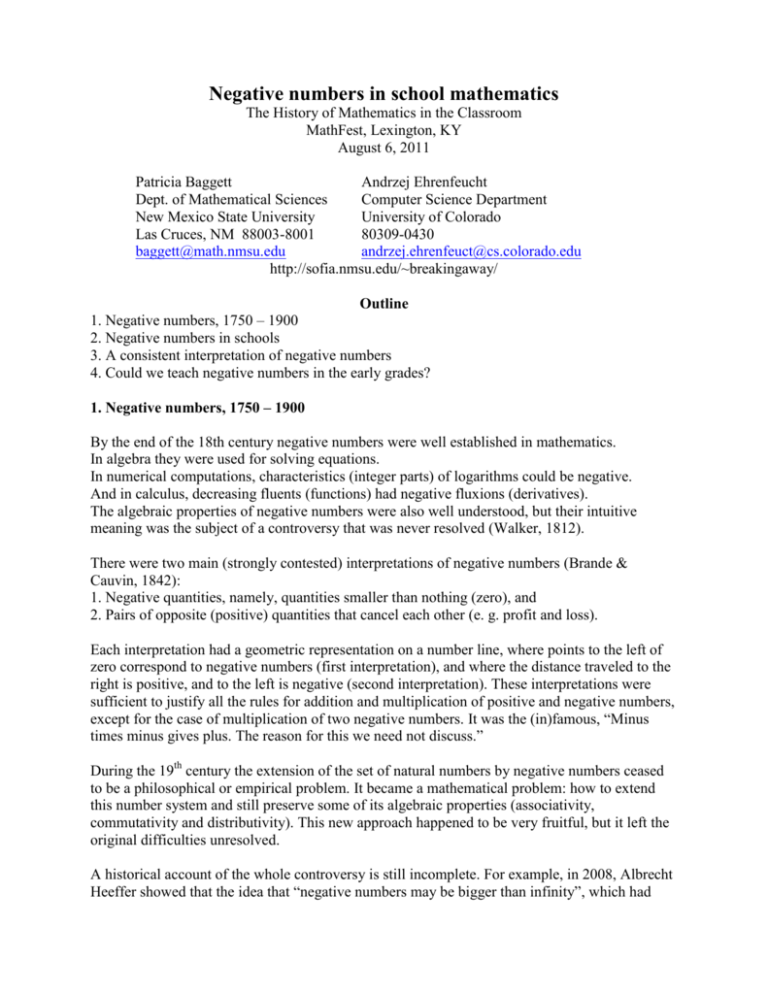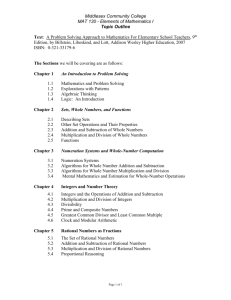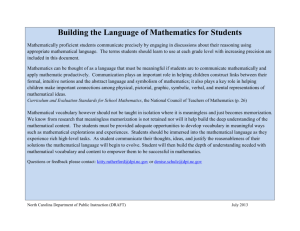Negative numbers in school mathematics
advertisement

Negative numbers in school mathematics The History of Mathematics in the Classroom MathFest, Lexington, KY August 6, 2011 Patricia Baggett Andrzej Ehrenfeucht Dept. of Mathematical Sciences Computer Science Department New Mexico State University University of Colorado Las Cruces, NM 88003-8001 80309-0430 baggett@math.nmsu.edu andrzej.ehrenfeuct@cs.colorado.edu http://sofia.nmsu.edu/~breakingaway/ Outline 1. Negative numbers, 1750 – 1900 2. Negative numbers in schools 3. A consistent interpretation of negative numbers 4. Could we teach negative numbers in the early grades? 1. Negative numbers, 1750 – 1900 By the end of the 18th century negative numbers were well established in mathematics. In algebra they were used for solving equations. In numerical computations, characteristics (integer parts) of logarithms could be negative. And in calculus, decreasing fluents (functions) had negative fluxions (derivatives). The algebraic properties of negative numbers were also well understood, but their intuitive meaning was the subject of a controversy that was never resolved (Walker, 1812). There were two main (strongly contested) interpretations of negative numbers (Brande & Cauvin, 1842): 1. Negative quantities, namely, quantities smaller than nothing (zero), and 2. Pairs of opposite (positive) quantities that cancel each other (e. g. profit and loss). Each interpretation had a geometric representation on a number line, where points to the left of zero correspond to negative numbers (first interpretation), and where the distance traveled to the right is positive, and to the left is negative (second interpretation). These interpretations were sufficient to justify all the rules for addition and multiplication of positive and negative numbers, except for the case of multiplication of two negative numbers. It was the (in)famous, “Minus times minus gives plus. The reason for this we need not discuss.” During the 19th century the extension of the set of natural numbers by negative numbers ceased to be a philosophical or empirical problem. It became a mathematical problem: how to extend this number system and still preserve some of its algebraic properties (associativity, commutativity and distributivity). This new approach happened to be very fruitful, but it left the original difficulties unresolved. A historical account of the whole controversy is still incomplete. For example, in 2008, Albrecht Heeffer showed that the idea that “negative numbers may be bigger than infinity”, which had been attributed to John Wallis and to Leonard Euler by some historians (e.g., Ball (1912), M. Kline (1972, 1980, 1983), Sandiger (2006), Dunham (2007)), was based on a misreading of the original text. In a nutshell, their argument was like this: “ 2 > 1 > 0 > -1, so we may expect 1/2 < 1/1 < 1/0 < 1/-1. But if 1/0 = , then < 1/-1. We know that 1/-1 = -1, so < -1.” But it was the identity 1/-1 = -1 that was questioned by Wallis and Euler. 2. Negative numbers in schools today In schools, all mathematical concepts are introduced through everyday intuitions. And this brings back the same difficulties that faced eighteenth century mathematicians, and which were bypassed during the nineteenth century. Here is a typical way of introducing negative numbers. It is taken from the Common Core Standards (2010), which may become obligatory in all schools in the United States. Negative numbers first occur in the Standards in Grade 6. Grade 6 Overview; The Number System 5. Understand that positive and negative numbers are used together to describe quantities having opposite directions or values (e.g., temperature above/below zero, elevation above/below sea level, credit/debit, positive/negative electric charges). 6. Understand a rational number as a point on the number line. a. Understand opposite signs of numbers as indicating locations on opposite sides of zero on the number line. 7. Understand ordering and absolute value of rational numbers. c. Understand the absolute value of a rational number as its distance from 0 on the number line. Grade 7 Overview; The Number System 2. Apply and extend previous understandings of multiplication and division and of fractions to multiply and divide rational numbers. a. Understand that multiplication is extended from fractions to rational numbers by requiring that operations continue to preserve the properties of operations, particularly the distributive property, leading to products such as (-1)(-1) = 1 and the rules for multiplying signed numbers. Comments The presentation of the material in the Core Standards follows its historical development; we have opposite quantities, numbers on both sides of zero, and finally the preservation of properties. But there are some problems. The interpretations presented are inconsistent. For example, [Grade 6 above] A number is a point on a number line. And [Grade 6(7c)] its absolute value is its distance from 0. So the absolute value of a number (a distance) is not a number (a point). There is a question about the validity of rules for negative numbers. Who is requiring that properties should be preserved [grade 7(2)]? How is the decision made about whether a property is preserved, or is not preserved? (The property that 0 is the smallest number is not preserved when we include negative numbers.) How are such requirements justified? One would expect that a proposal for a national curriculum would contain material that is free from logical errors. 3. A consistent interpretation of negative numbers Using positive numbers to measure any quantity is not controversial. So let’s consider a variable quantity x, look at its two values, x1 and x2 (e. g. two consecutive measurements), and try to record the change that occurred. There are three possible cases. 1. The value of x increased, x2 > x1. Their difference is x = x2 – x1. We record x. 2. The value of x decreased, x2 < x1 . Their difference is x = x1 – x2. We record -x. So a positive number, x, indicates an increase of the value of x, and a negative number, -x, indicates a decrease. 3. The value of x did not change, x1 = x2. The amount of change is x = 0. We record 0. Zero indicates no change. Addition of two changes, (1 + 2), is the result of the composition of two consecutive changes. And the only meaning of subtraction is addition of the opposite, (1 + -2). This model gives an intuitive meaning to the concept of negative numbers, and to the addition of both positive and negative numbers. It also explains why a positive change can be treated as any other quantity. If x > 0, then x2 = x1 + x. So the new amount of x is the sum of the previous amount and the amount of difference. This is not true for x < 0. So we already see a lack of symmetry between the positive and negative numbers. Interpretation of multiplication We look at the ratio r = 2/1 of two changes, 1 and 2, of the variables x and y, and at the corresponding product, r*1 = 2. When both variables x and y are increasing, or both are decreasing, the ratio is positive because it is the ratio of two “denominate” quantities of “the same kind”. In the case when one variable is increasing and the other decreasing, we use a negative number for the ratio of their differences, assigning to it the following meaning: The ratio r is negative when one of the variables is increasing and the other is decreasing. So in the same arithmetic expression, the minus sign, -, may have two different meanings: 1st, the variable was decreasing; and 2nd, the ratio is between two changes in opposite directions. Here are illustrative examples of r = 2/1 and r*1 = 2 (Here, - indicates the 1st meaning, and - the 2nd meaning.) r = 2/1 r*1 = 2 3 = 6/ 2 3 = -6/-2 3* 2 = 6 3*-2 = -6 -3 = -6/ 2 -3 = 6/-2 -3* 2 = -6 -3*-2 = 6 Here, -2 means that variable x decreased by 2. And -3 means that the changes of x and y were in opposite directions. So variable y increased by 6. In the last row of the table, we see that -3*-2 = 6. This interpretation is not “easy” or “obvious”, but it is consistent. Remark You may notice that this interpretation of negative numbers is an elementary version of their use in differential calculus. 4. Could we teach negative numbers in the early grades? Children in early elementary grades do not seem to have any problem in using negative numbers to describe changes. For example: Third grade students in a New Mexico school recorded daily temperatures in the range 70F to 100F; they recorded hour-to-hour and day-to-day differences as positive or negative numbers; and they did several tasks involving computation, using four-operation calculators. But integrating the use of negative numbers with a curriculum for early grades would require several radical changes. For example, an intuitive justification of the rules for multiplication that are shown above requires the concept of a ratio. And at present (Common Core Standards) ratio is introduced in sixth grade, and multiplication of whole numbers starts in second grade as repeated addition, which is later extended to multiplication of fractions (presented as parts of a whole), which renders multiplication of negative numbers meaningless. Also, ratio in sixth grade is introduced in the context of “proportional reasoning”, and not “rate of growth”, which is a high school topic. So introducing negative numbers early would require several changes in grade placement of other topics, and in the methods of their presentation. But there are two strong reasons for introducing negative numbers early. (1) All computer technology uses negative numbers. So students before 6th grade either avoid technology, or learn it without guidance and without sufficient mathematical background, often forming serious misconceptions. For example, “The calculator shows minus to tell you that you made an error.” (2) Several mental and written arithmetic algorithms become simpler when you use negative numbers. An example: Most people can add at a glance the following list of numbers: 1, 3, 1, 2. It is 7. But what about this list? 9, 7, 9, 8 Well, -1, -3, -1, -2 adds up to -7, and -7 + 40 is 33. Final remark The history of mathematics, besides showing progress, also shows some dead ends. But when we present material along the lines of their historical development, do we need to lead students to these dead ends? References Ball, Walter William Rouse (1912). A Short Account of the History of Mathematics, London: Macmillan and Co. (Dover reprint, 1960). Brande, W.T. & Cauvin, Joseph (1842). A Dictionary of Science, Literature, and Art: Comprising the History, Description, and Scientific Principles of Every Branch of Human Knowledge, London: Longman, Green, Brown, and Longman. Common Core Standards (2010). Retrieved 7-20-2011 from http://www.corestandards.org/ Dunham, William (2007). The Genius of Euler: Reflections on His Life and Work, Washington, DC: Mathematics Association of America. Heeffer, Albrecht (2008). Negative Numbers as an Epistemic Difficult Concept: Some Lessons from History. In Costas Tzanakis (ed.) History and Pedagogy of Mathematics. Satellite Meeting of International Congress on Mathematical Education 11, 14 - 18 July 2008, Centro Cultural del México Contemporáneo, Mexico City, México, CD-ROM, Section I, 13, pp. 1-13. Kline, Morris (1972). Mathematical Thought from Ancient to Modern Times, Oxford: Oxford University Press, (reprinted in 3 vols. 1990). Kline, Morris (1980). Mathematics: The Loss of Certainty, Oxford: Oxford University Press. Kline, Morris (1983). Euler on Infinite Series, Mathematics Magazine, 56 (5), 307-314. Sandiger, Edward C. (2006). How Euler Did It, Washington, DC: Mathematics Association of America. Walker, John (1812). The Philosophy of Arithmetic (Considered as a Branch of Mathematical Science); and The Elements of Algebra, Dublin: R. Napper.








